Adjectives Gritty Synonyms Figurative Reviews of Broken Mirror Tng
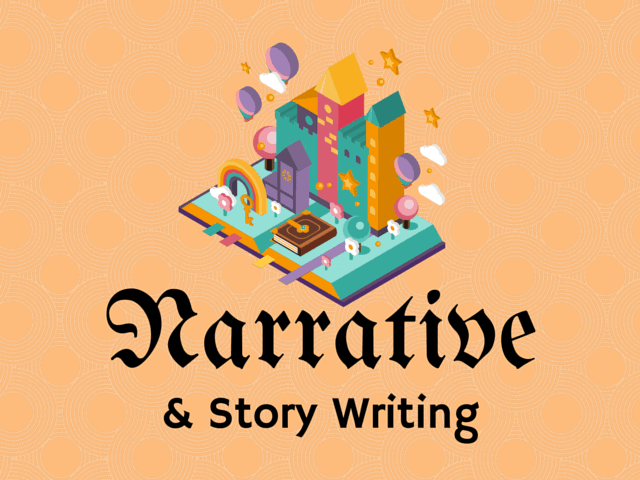
THE CRAFT OF NARRATIVE WRITING
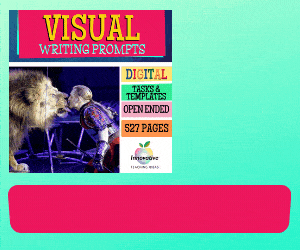
Good narrative writing skills are hard-won by our students. They build on and encourage the development of, a good grasp of the mechanics of writing. They also require the evolution of an additional skill set, notwithstanding, namely the ability to tell a expert yarn. Telling stories is every bit former as humanity.
We run across and hear stories everywhere and on a daily footing. From having a good gossip on the doorstep with a neighbor in the forenoon to the advertisements that bombard u.s. from billboards and radio on our daily commute. Much is made of the fine art of storytelling, but luckily for us, and our students, weaving a good tale is a craft as well and crafts can be taught, practised, and perfected over fourth dimension. Hither we will look at some of the main elements that comprise a good story: setting, characters, problem, climax, and resolution. And we will expect likewise at how best we can assist our students understand these elements, both in isolation and how they mesh together equally a whole.
WHAT IS A NARRATIVE?

Narratives are a popular genre for students and teachers as it provides the writer with an opportunity to share their imagination, creativity, skill, and understanding of nearly all elements of writing. On occasion, nosotros refer to a narrative every bit 'creative writing' or story writing.
The purpose of a narrative is simple, to tell the audition a story. Information technology tin be written to motivate, brainwash or well-nigh normally entertain. Narratives can exist both fact or fiction.
The claiming in writing a skilful narrative is to captivate the audience and keep them engaged equally the story is told.
A Complete UNIT ON NARRATIVE WRITING FOR STUDENTS & TEACHERS
Teach your students to become skilled story writers with this HUGENARRATIVE & CREATIVE STORY WRITING Unit. Offering a COMPLETE SOLUTION to pedagogy students how to arts and craftsArtistic CHARACTERS, SUPERB SETTINGS, PERFECT PLOTS.
Over 192 PAGES of materials including:
TYPES OF NARRATIVE WRITING
There are many narrative writing genre's and sub genre's, such as these.
We also have a consummate guide to writing a personal narrative that differs from the traditional narrative covered in this guide. It includes personal narrative writing prompts, resources, examples and tin be plant here.
AS THE Higher up IMAGES ILLUSTRATE NARRATIVES ARE AN Open up OPEN-ENDED Grade OF WRITING ALLOWING YOU TO SHOWCASE YOUR Creativity IN Any DIRECTION. HOWEVER, ALL NARRATIVES SHARE A Mutual Prepare OF FEATURES AND Construction Every bit OUTLINED BELOW
PLANNING YOUR WRITING Fourth dimension EFFECTIVELY
Don't overlook the importance of understanding story elements every bit a reader, and the value this adds to yous as a author who tin can dissect and create smashing narratives. Nosotros take a complete guide to story elements here.
Maximize your narrative writing sessions by spending approximately 20 per cent of your time planning and preparing. This ensures greater productivity during your actual writing time as well as keeping yous focussed and on task.
Utilise tools such every bit graphic organizers such equally those found beneath to logically sequence your narrative if you are not a confident story writer. If you are working with reluctant writers endeavour using some narrative writing prompts to go their creative juices flowing.
Spend the majority of your writing hour on the task at mitt, and don't get as well side-tracked editing during this time.
When editing a narrative read it for three elements.
- Spelling and grammar ( Is it readable?)
- Story structure and continuity ( Does make sense and does it period? )
- Graphic symbol and plot analysis. (Are your character's engaging? Does your problem / resolution work? )
CHARACTERISTICS OF NARRATIVE WRITING
NARRATIVE STRUCTURE
ORIENTATION (Offset) Set the scene by introducing your characters, setting and time of the story. Establish your who, when and where in this part of your narrative
COMPLICATION AND EVENTS (MIDDLE) In this section activities and events involving your main characters are expanded upon. These events are written in a cohesive and fluent sequence.
RESOLUTION (Ending) Your complication is resolved in this section. It does non take to be a happy outcome, however.
EXTRAS: Whilst orientation, complication and resolution are the agreed norms for a narrative at that place are numerous examples of popular texts that did non explicitly follow this path exactly.
NARRATIVE FEATURES
Linguistic communication Use descriptive and figurative language that will paint images inside your audience's minds as they read.
PERSPECTIVE Narratives tin be written from any perspective but are almost usually written in first or 3rd person.
DIALOGUE Narratives ofttimes switch from narrator to get-go-person dialogue. Ever employ speech marks when writing dialogue.
TENSE If you alter tense brand it perfectly clear to your audition what is happening. Flashbacks might work well in your mind but make sure they translate to your audience.
THE 5 Primal STORY ELEMENTS OF A GREAT NARRATIVE ( six MINUTE TUTORIAL VIDEO)
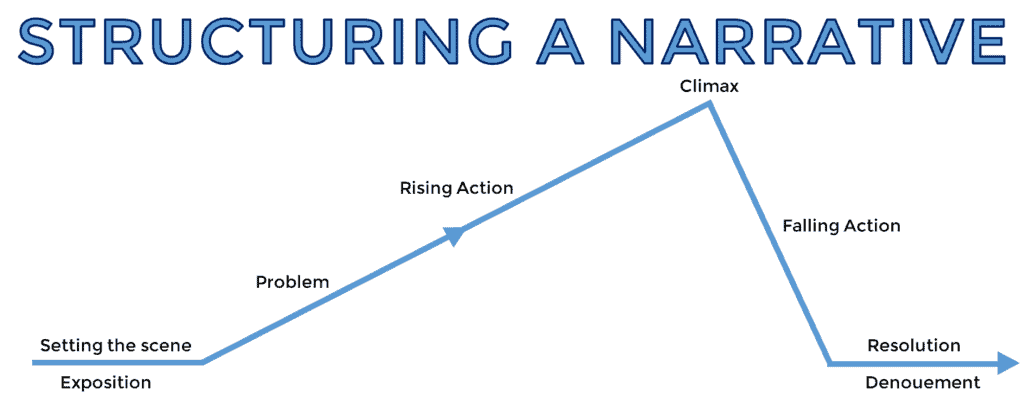
ALTHOUGH NARRATIVES CAN TAKE MANY Different FORMS AND CONTAIN MULTIPLE CONFLICTS AND RESOLUTIONS Nigh ALL FIT THIS Structure IN 1 Mode OR ANOTHER.
ane. SETTING THE SCENE: THE WHERE AND THE WHEN
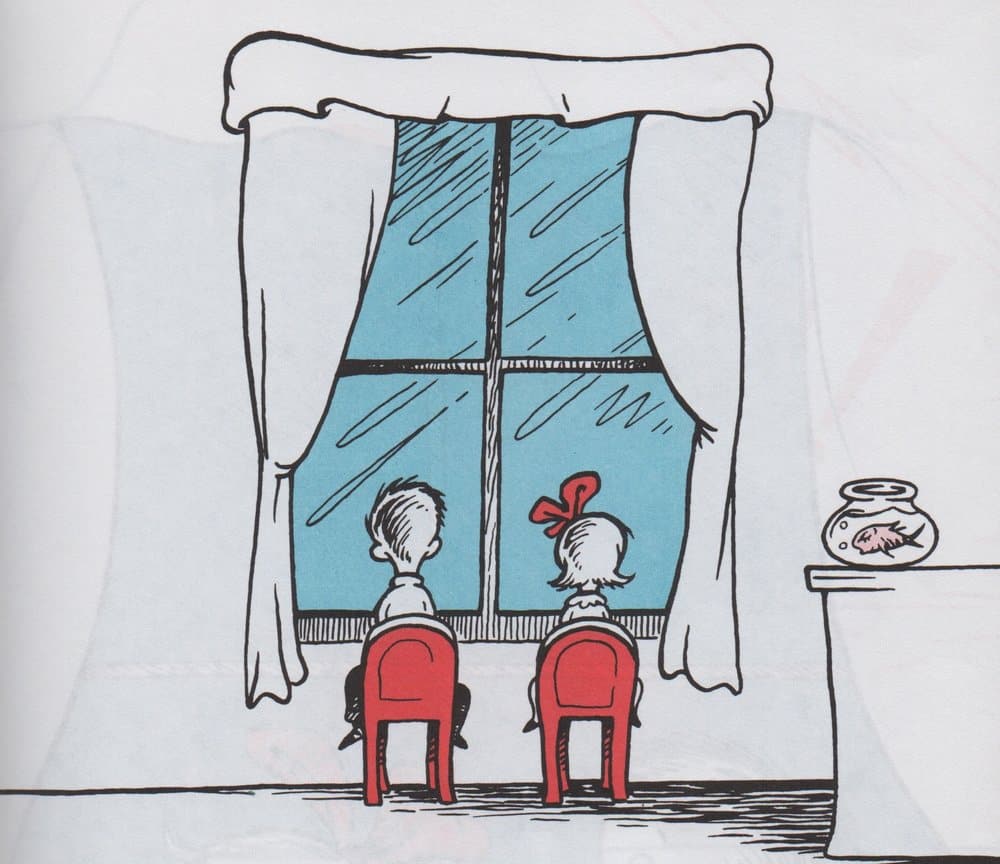
The setting of the story oftentimes answers two of the central questions of the story, namely, the where and the when. The answers to these two important questions will often be informed by the type of story the educatee is writing. The setting of the story can be called to speedily orientate the reader to the blazon of story they are reading. For instance, a fictional narrative writing piece such equally a horror story volition often begin with a clarification of a haunted business firm on a colina or on an abased aviary in the middle of a wood. If we begin our story on a rocket ship hurtling through the creation on its space voyage to the Alpha Centauri star system, we can exist fairly certain that the story we are embarking on is a work of science fiction. Such conventions are well-worn clichés true, but they can exist helpful starting points for our novice novelists to make a start.
Having the students choose an appropriate setting for the blazon of story the student wishes to write is a great exercise for our younger students. It leads naturally onto the next stage of story writing which is the creation of suitable characters to populate this fictional world they have created. Withal, older or more than advanced students may wish to play with the expectations of advisable settings for their story. They may wish to practice this for comic upshot or in the interest of creating a more than original story. For example, opening a story with a children'southward altogether political party does non unremarkably set up the expectation of a horror story, and indeed it may even lure the reader into a happy reverie equally they remember their own happy altogether parties. This leaves them more vulnerable to the surprise element of the shocking activity that lies alee.
Once the pupil has chosen a setting for their story, they need to go started on the writing. There is little that can be more terrifying to English students than the bare folio and its bare whiteness that stretches earlier them on the table like a merciless desert they have to cross. Give them the boot-start they need by offering support through word banks or writing prompts. If the class is all writing a story based on the same theme, you may wish to compile a mutual discussion bank on the whiteboard equally a prewriting activeness. Write the primal theme or genre in the middle of the board. Have students advise words or phrases related to the theme and list them on the board. Yous may wish to provide students with a copy of various writing prompts to go them started. While this may mean that many students' stories will have the same starting time, virtually likely they will arrive at dramatically different endings via dramatically unlike routes.
There is a bargain at the centre of the relationship between writer and reader. That bargain is that the reader promises to append their disbelief equally long as the writer creates a consistent and convincing fictional reality. Creating a conceivable world for the fictional characters to inhabit requires the student to draw on convincing details. The best way of doing this is through writing that appeals to the senses. Have your student reflect deeply on the world which they are creating. What does it look like? Sound similar? What does the food sense of taste similar at that place? How does it feel like to walk those imaginary streets and what aromas beguile the nose equally the main character winds their way through that conjured market? Requite consideration to the when, is it a world of the futurity where things are cleaner and more antiseptic? Or is it an overcrowded 16th century London with man waste matter stinking upwardly the streets. If students can create a multi-sensory installation in the reader's listen then they accept washed this role of their task well.
2. CASTING THE CHARACTERS: THE WHO

Now that your student has created a believable earth, it is time to populate it with conceivable characters. In brusk stories, it is important that these worlds are non overpopulated across what the skill level of the student can manage. For the most role, brusk stories usually only crave one main character and few secondary ones. Think of the short story more than as a modest-calibration dramatic production in an intimate local theater than a Hollywood blockbuster on the grand calibration. Besides many characters volition but lead to confusion and go unwieldy with a canvas this size. Keep it elementary!
Creating believable characters is oftentimes i of the about challenging aspects of narrative writing for students. Fortunately, there are a few things nosotros can practice to help students hither. Sometimes it is helpful for students to model their characters on actual people they know. This tin can make things a little less daunting and taxing on the imagination. Even so, whether or not this is the case, writing up brief background bios or descriptions of characters' physical on personality characteristics tin be a very useful prewriting action. Students should requite some in-depth consideration to the details of who their character is: How practise they walk? What do they wait like? Practise they have any distinguishing features? A crooked nose? A limp? Bad breath? Including small details such every bit these bring life and therefore believability to characters. Students can even cut pictures from magazines to put a face to their character and let their imaginations to fill in the balance of the details.
Younger students will often dictate to the reader the nature of their characters. For students to improve their writing craft, it is important they know when to switch from story-telling manner to story-showing mode. This is specially truthful when it comes to character. Encourage students to reveal their character's personality through what they do rather than merely by lecturing the reader on the faults and virtues of the character's personality. It might be a modest relayed detail in the way they walk that reveals a core characteristic. For example, a character who walks with head hanging low and shoulders hunched while fugitive eye contact has been revealed to be timid without the word once being mentioned. This is a much more artistic and well-crafted way of doing things and less irritating for the reader. A character who sits down at the family dinner table and immediately snatches up his fork and starts stuffing roast potatoes into his oral cavity before anyone else has even managed to sit down has revealed a tendency towards greed or gluttony.
Understanding Graphic symbol Traits
Again, there is room here for some fun and assisting prewriting activities. Give students a list of grapheme traits and take them describe a graphic symbol doing something that reveals that trait without ever employing the word itself.
It is also important to avoid adjective stuffing here. When looking at students' early on drafts describing word stuffing is oftentimes credible. To train the student out of this habit, choose an adjective and have the pupil rewrite the sentence to express this adjective through action rather than telling.
3. NO PROBLEM? NO STORY! THE WHY AND THE WHAT

This is often the area apprentice writers have the nearly difficulty with. It is of import that students sympathise that without a trouble in that location is no story. The problem is the driving force of the action. Usually, in a curt story the problem will heart around what the main character wants to happen or, indeed, wants not to happen. It is the hurdle that must be overcome. It is in the struggle to overcome this hurdle that events happen.
Often when a student understands the need for a problem in a story their completed work will still not be successful. This is considering oft in life problems remain unsolved. Hurdles are not always successfully overcome. Students pick up on this. We oftentimes discuss problems with friends that will never be satisfactorily resolved 1 way or the other and we accept this as a part of life. This is non unremarkably the case with writing a story. Whether a character successfully overcomes his or her problem or is decidedly crushed in the process of trying is non as important as the fact that ane way or the other, information technology will finally be resolved.
A skilful applied exercise for students to get to grips with this is to provide them with copies of stories and have them identify the key problem in each through give-and-take. Familiar fables or fairy tales such as Three Little Pigs, The Boy Who Cried Wolf, Cinderella, etc are cracking for this.
While it is truthful that stories often have more one problem or that the hero or heroine is unsuccessful in their first try to solve a central trouble, for showtime students and intermediate students it is best to focus on a single trouble, peculiarly given the telescopic of story writing at this level. Over time students will develop their abilities to handle more than complex plots and write accordingly..

4. THE NARRATIVE CLIMAX: HOW THINGS COME TO A Head!

The climax of the story is the dramatic high signal of the action. It is also when the struggles kicked off past the problem come up to a head. The climax will ultimately decide whether the story volition accept a happy or tragic ending. In the climax, two opposing forces duke things out until the bitter (or sweetness!) finish. One forcefulness ultimately emerges triumphant. As the action builds throughout the story suspense increases equally the reader wonders which of these forces will win out. The climax is the release of this suspense.
Much of the success of the climax depends on how well the other elements of the story have been achieved. If the student has created a well-drawn and believable character that the reader can identify with and feel for and then the climax will be more powerful. The nature of the problem too is essential as it determines what'southward at stake in the climax. The trouble must matter dearly to the main grapheme if information technology is to matter at all to the reader.
Have students engage in discussions nigh their favorite movies and books. Accept them think about the storyline and decide what were the most exciting parts. What was at stake at these moments? What happened in your trunk as you read or watched? Did you lot breathe faster? Or grip the absorber hard? Did your heart charge per unit increase or did you outset to sweat? This is what a expert climax does and what our students should strive to do in their ain stories.
The climax puts it all on the line and rolls the die. Let the chips fall where the author may…
5. RESOLUTION: TYING UP LOOSE ENDS
Frequently, after the climactic activity, a few questions volition remain unresolved for the reader, fifty-fifty if all the conflict has been resolved. The resolution is where those lingering questions volition be answered. Information technology may be that in a short story the resolution volition merely be a cursory paragraph or two. But, in most cases information technology will still be necessary to include every bit an ending immediately afterwards the climax can experience besides abrupt and leave the reader feeling unfulfilled.
Exist sure to check out our own complete guide to writing perfect paragraphs here.
An easy fashion to explain resolution to students who are struggling to grasp the concept is to point to the traditional resolution of fairy tales, the "And they all lived happily ever later" catastrophe. This weather condition forecast for the futurity allows the reader to take their get out. Take the educatee consider the emotions they want to go out the reader with when crafting their resolution.
While usually, the activeness is complete by the end of the climax, information technology is in the resolution that if there is a twist exist found it will appear – think of movies such every bit The Usual Suspects. To pull this off convincingly usually requires considerable skill on the part of a educatee writer, but it may well form a challenging extension exercise for those more gifted storytellers amidst your students.
THE Parting WORDS:
Once students take completed their story they can then go back and edit for grammar, vocabulary pick, spelling, etc. but not before! Every bit mentioned, there is a craft to storytelling, too equally an art. When accurate grammar, perfect spelling, and immaculate sentence structures are pushed at the outset they can cause storytelling paralysis. For this reason, it is of import that when nosotros encourage the students to write a story we requite them license to make the mechanical mistakes in their use of language that they can work on and fix later.
Practiced narrative writing is a very complex skill to develop and will have the student years to become competent in. It challenges not merely the educatee's technical abilities with language but also her creative faculties. The use of writing frames, word banks, mind maps, and visual prompts tin all give valuable back up as students develop the wide-ranging and challenging skills required to produce a successful slice of narrative writing. But, at the end of it all, as with any arts and crafts, practise and more practice is at the eye of the affair.
TIPS FOR Bang-up NARRATIVE WRITING
- Set the scene and appoint your audition early on with well thought out characters and setting.
- Innovate a problem or complication that causes an issue which gives your story purpose.
- Entertain us. Narratives are the near popular of all styles of writing. If you tin can't entertain and engage u.s. y'all audience volition quickly motion on.
Instruction Resources
Employ the resource and tools below with your students to improve their writing skills through proven teaching strategies.
The unmarried biggest challenge many students face when information technology comes to story writing is coming up with inspiration or ideas to get those creative juices flowing. Some students will have more ideas than hours in the day and others will always struggle for both ideas and direction.
When teaching narrative writing it is essential that you have a range of tools, strategies and resource at your disposal to ensure you become the most out of your writing fourth dimension. Yous can find some examples of these below.
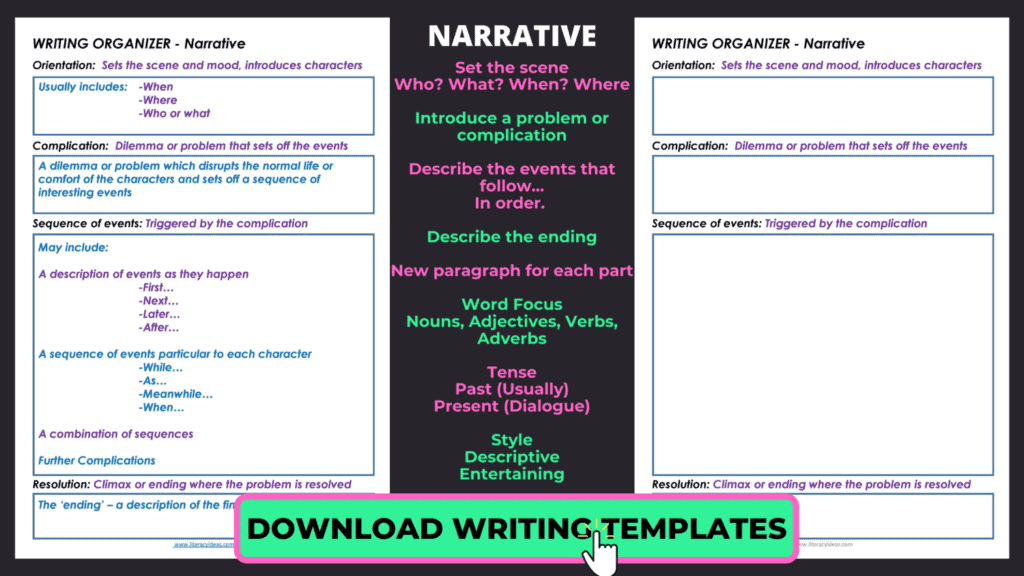
EXAMPLES OF NARRATIVE WRITING (Student Writing Samples)
Below are a collection of pupil writing samples of narratives. Click on the image to overstate and explore them in greater detail. Please have a moment to both read the creative stories in detail and the instructor and educatee guides which highlight some of the fundamental elements of narratives to consider earlier writing.
Please understand these student writing samples are non intended to exist perfect examples for each age or form level only a piece of writing for students and teachers to explore together to critically analyze to improve student writing skills and deepen their agreement of story writing.
Nosotros would recommend reading the case either a year higher up and below, every bit well equally the grade y'all are currently working with to gain a broader appreciation of this text blazon.
NARRATIVE WRITING CHECKLIST Packet

NARRATIVE WRITING PROMPTS (Journal Prompts)
Below is a collection of narrative writing topics to profoundly enhance the writing procedure. These writing ideas accept been selected to encourage students to call up critically about writing a great artistic story.
When students have a great journal prompt it tin really assist them focus on the job at hand. Be sure to check out our huge drove of visual writing prompts for a range of text types here.
- On a recent trip to Europe you observe your travel grouping booked into the both stunning and mysterious Castle Frankenfurter for a single dark… As night falls the huge castle of over one hundred rooms seems to creak and groan as a series of unexplained events begin to make yous wonder who, or what else is spending the evening with you? Write a narrative that tells the story of your evening.
- You are a famous adventurer who has discovered new lands, keep a travel log over a period of fourth dimension in which you encounter new and heady adventures and challenges to overcome. Ensure your travel journal tells a story and has a definite introduction, disharmonize and resolution.
- Yous create an incredible piece of technology which has the capacity to alter the world. As y'all sit back and marvel at your innovation and the countless possibilities that lay ahead of you information technology becomes credible at that place are a few bug you didn't really consider, and you might not be able to even control them. Write a narrative in which you lot ride the highs and lows of your earth changing creation with a clear introduction, disharmonize and resolution.
- As the final door shuts on the Megamall you realise yous have done information technology… You and your best friend have managed to sneak into the largest shopping center in town and accept the entire place to yourselves until 7am tomorrow. There is literally everything and anything a child would dream to entertain themselves for the adjacent 12 hours. What amazing adventures look you? What might go wrong? And how will y'all leave of there scot-free?
- A stranger walks into town? Whilst appearing similar to near all those effectually you, you get a sense that this person is from another time, infinite or dimension… Are they friend or foe? What makes y'all sense something very foreign is going on? Of a sudden they stand up and walk toward yous with purpose extending their hand… It'south most every bit if they were reading your mind.
THE STORY TELLERS Package OF TEACHING Resource

A MASSIVE Drove of resources for narratives and story writing in the classroom covering all elements of crafting amazing stories. WEEKS WORTH OF WRITING LESSONS AND Resources including:
NARRATIVE WRITING VIDEO TUTORIALS
OTHER Corking Manufactures ABOUT NARRATIVE WRITING

Narrative Writing for Kids: Essential Skills and Strategies
It's tough getting junior writers to create a well-written story, but we accept some excellent strategies and advice for teachers and students here.

5 Great Narrative Lesson Plans for Students and Teachers
Learn how to write fantabulous stories in a single calendar week with this complete guide for teachers and students.
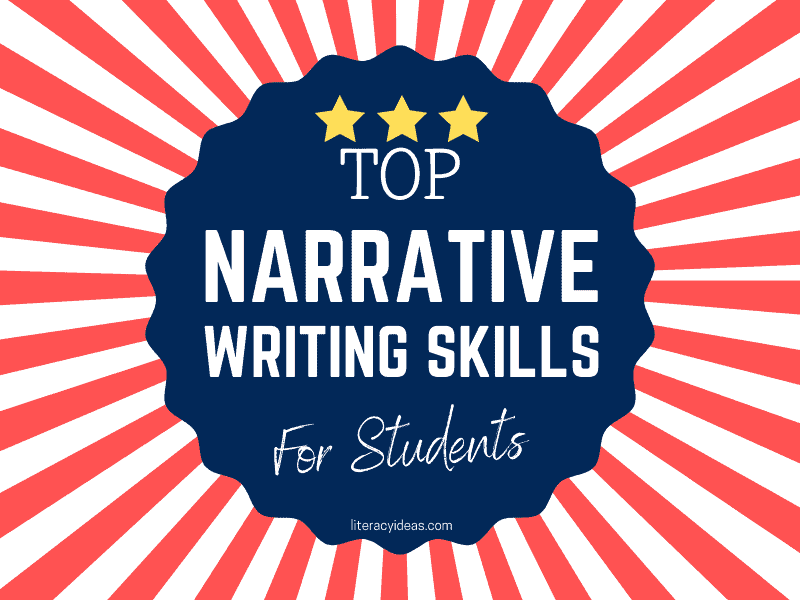
Meridian 7 Narrative Writing Exercises for Students
Larn the essential skills for writing an first-class narrative including character cosmos, crusade and effect, dialogue, tension, themes, and a conclusion. Learn teaching strategies to improve educatee writing skills.
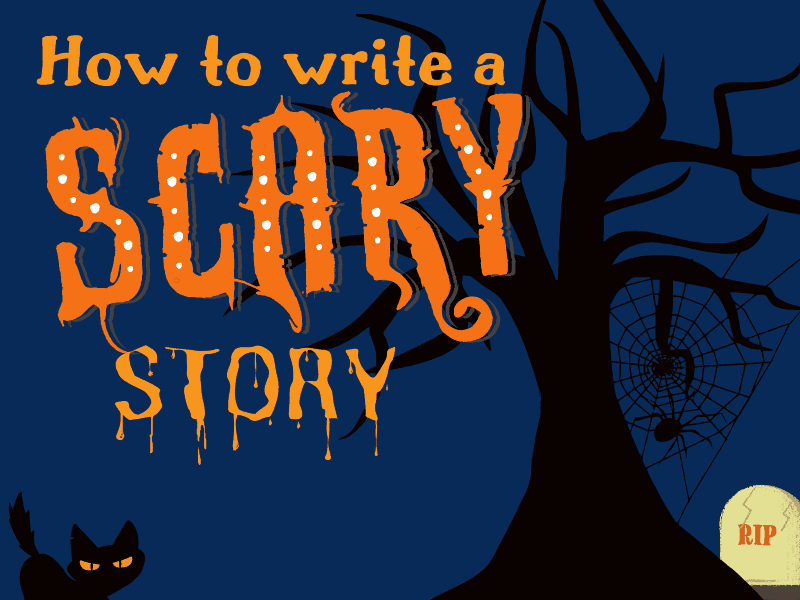
How to write a scary story
How to Write a Scary Story: 5 Terrifying Tips to Help Students Scare the Life Out of Readers Near of u.s. love a expert scare! From our beginning game of peek-a-boo as a child, through those ghost stories around a campfire equally a teen, surprises and a little fearfulness or 2 never lose their…
Content for this page has been written by Shane Mac Donnchaidh. A former principal of an international school and university English lecturer with xv years of teaching and administration experience. Shane's latest Volume the Complete Guide to Nonfiction Writing can exist constitute here. Editing and back up for this article have been provided past the literacyideas team.
willcockhicappeed.blogspot.com
Source: https://literacyideas.com/narrative-writing/

0 Response to "Adjectives Gritty Synonyms Figurative Reviews of Broken Mirror Tng"
Post a Comment